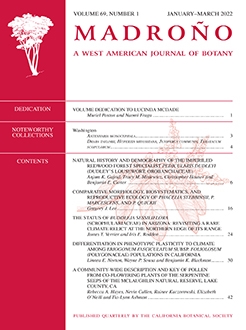Rio Grande Butterfly Bush, Buddleja sessiliflora Kunth (Scrophulariaceae), reaches its northernmost distribution in southeast Arizona, and herbarium records document seven historical localities from Pima and Santa Cruz counties. Between 2014–2020, we visited six of the documented historical localities, but could not access the seventh location reported from the Tohono O'odham Nation. We found one of these historical locations is no longer extant. Two recently discovered new sites were also visited. We verified a total of 30 plants, in nine populations, from seven distinct localities during this research, which included the two previously unknown sites. Five of the seven localities were restricted to 6–15 m diameter areas and contained between one and seven plants, while the other two localities each included two disjunct 5 m diameter clusters of plants. We only found two small plants, which are likely seedlings or propagules. It is unclear why these plants rarely reproduce in situ, either sexually or vegetatively. These isolated riparian populations experience environmental stress, including hotter drought, diminishing water resources, anthropogenic habitat disturbance, and invasive plant species. This study resulted in an Arizona state designation for B. sessiliflora of ‘S1: critically imperiled.’ Buddleja sessiliflora may be one of the rarest plants in southern Arizona, and these peripheral populations face an increased extirpation risk.
How to translate text using browser tools
21 April 2022
THE STATUS OF BUDDLEJA SESSILIFLORA (SCROPHULARIACEAE) IN ARIZONA: REVISITING A RARE CLIMATE RELICT AT THE NORTHERN EDGE OF ITS RANGE
James T. Verrier,
Iris E. Rodden
ACCESS THE FULL ARTICLE

Madroño
Vol. 69 • No. 1
January–March 2022
Vol. 69 • No. 1
January–March 2022
Arizona
Buddleja sessiliflora
peripheral populations
range contraction
rare species




